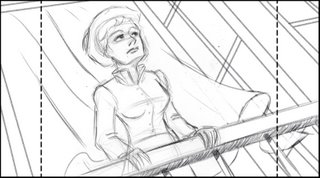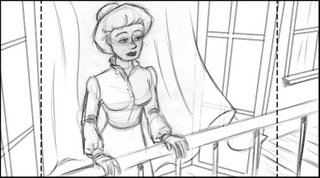
One of the ways you can change the mood of a scene is simply by changing the angle of the camera. In this post I have presented the same basic scene from 3 slightly different camera angles. I purposefully kept the camera on the same side of the character to help show how the change can effect the feeling of the scene. To begin with I have a level camera to the character. Here you get the feeling the lady is remembering something or someone. A scene like this often is accompanied by a camera move either in or out depending upon the point in the story that it appears. Next I have a low camera angle that give a more heroic or dramatic feeling.

With this type of camera angle give the character a sense of accomplishment. Either that they will be able to overcome or have already have triumphed. It's basically putting the character on a pedestal. It harkens back to the age of Kings and Queens standing on their balconies looking down upon the peasants. Of course this camera angle can be pushed to the point that a character appears taller than they are. Even old propaganda posters used images of people from low angles. Accompanied with harsh shadows can make it even feel sinister. Often you will see films in which a character that is in a desperate situation use low camera angles with harsh shadows.

The opposite of this is the downshot or high camera angle. It gives a sense of bewilderment or loss. That perhaps the character didn't get what they were after. Like the first example you will often find a shot like this accompanied with a camera move out. It can also be pushed to give a stronger feeling. A downshot also helps to give scale and place the characters into their world. In many live action movies a crane is used to bring the camera to this angle. No matter how you use these angles it's always good to keep in mind that the angle should not feel out of place. I find it is always best for you audience to not be so aware of the camera. This included camera moves.
 One of the ways you can change the mood of a scene is simply by changing the angle of the camera. In this post I have presented the same basic scene from 3 slightly different camera angles. I purposefully kept the camera on the same side of the character to help show how the change can effect the feeling of the scene. To begin with I have a level camera to the character. Here you get the feeling the lady is remembering something or someone. A scene like this often is accompanied by a camera move either in or out depending upon the point in the story that it appears. Next I have a low camera angle that give a more heroic or dramatic feeling.
One of the ways you can change the mood of a scene is simply by changing the angle of the camera. In this post I have presented the same basic scene from 3 slightly different camera angles. I purposefully kept the camera on the same side of the character to help show how the change can effect the feeling of the scene. To begin with I have a level camera to the character. Here you get the feeling the lady is remembering something or someone. A scene like this often is accompanied by a camera move either in or out depending upon the point in the story that it appears. Next I have a low camera angle that give a more heroic or dramatic feeling. With this type of camera angle give the character a sense of accomplishment. Either that they will be able to overcome or have already have triumphed. It's basically putting the character on a pedestal. It harkens back to the age of Kings and Queens standing on their balconies looking down upon the peasants. Of course this camera angle can be pushed to the point that a character appears taller than they are. Even old propaganda posters used images of people from low angles. Accompanied with harsh shadows can make it even feel sinister. Often you will see films in which a character that is in a desperate situation use low camera angles with harsh shadows.
With this type of camera angle give the character a sense of accomplishment. Either that they will be able to overcome or have already have triumphed. It's basically putting the character on a pedestal. It harkens back to the age of Kings and Queens standing on their balconies looking down upon the peasants. Of course this camera angle can be pushed to the point that a character appears taller than they are. Even old propaganda posters used images of people from low angles. Accompanied with harsh shadows can make it even feel sinister. Often you will see films in which a character that is in a desperate situation use low camera angles with harsh shadows. The opposite of this is the downshot or high camera angle. It gives a sense of bewilderment or loss. That perhaps the character didn't get what they were after. Like the first example you will often find a shot like this accompanied with a camera move out. It can also be pushed to give a stronger feeling. A downshot also helps to give scale and place the characters into their world. In many live action movies a crane is used to bring the camera to this angle. No matter how you use these angles it's always good to keep in mind that the angle should not feel out of place. I find it is always best for you audience to not be so aware of the camera. This included camera moves.
The opposite of this is the downshot or high camera angle. It gives a sense of bewilderment or loss. That perhaps the character didn't get what they were after. Like the first example you will often find a shot like this accompanied with a camera move out. It can also be pushed to give a stronger feeling. A downshot also helps to give scale and place the characters into their world. In many live action movies a crane is used to bring the camera to this angle. No matter how you use these angles it's always good to keep in mind that the angle should not feel out of place. I find it is always best for you audience to not be so aware of the camera. This included camera moves.


5 Comments:
very cool info. Did you teach boarding at the Union?
Alfred Hitchcock once said there is only one good place to put a camera for a scene. It's your job to find it.
Once when Lillian Gish came to a set, the director had set the camera at floor level looking up at her walking. She asked whose point of view the audience was getting - an ant's?
This has pretty much been my credo. I want to know who the camera represents. Today most artists creating animation boards are too influenced by comic books, not films.
Of course Orson Welles purposefully broke some of the rules I believe in and made the films of a genius.
Good day. While browsing the Internet, I saw your website and wondered if you might be able assist me in finding a particular motion picture camera graphic. I've seen a picture of this graphic and I recall it resembling a speedometer, an arched weep of numbers, possibly negative to positive, "9:00 to 3:00", counted in "tens". In an similar arch set below the other, is clearly a series of ovals, a vertical line at center, "12:00", and a sweep to "9:00" and "3:00" of ever widening ovals. My interest in the graphic is in reference to a theatrical production about Mr. Hitchcock and we wish to use the graphic in a projection.
Thanks for your time . . .
Regards
Good day. While browsing the Internet, I saw your website and wondered if you might be able assist me in finding a particular motion picture camera graphic. I've seen a picture of this graphic and I recall it resembling a speedometer, an arched weep of numbers, possibly negative to positive, "9:00 to 3:00", counted in "tens". In an similar arch set below the other, is clearly a series of ovals, a vertical line at center, "12:00", and a sweep to "9:00" and "3:00" of ever widening ovals. My interest in the graphic is in reference to a theatrical production about Mr. Hitchcock and we wish to use the graphic in a projection.
Thanks for your time . . .
Regards
David Yates
Alina, I do teach digital storyboarding at the union, though I don't get into the specifics of techniques.
Michael, nice story! I have always studied Hitchcock among others. Thanks for the input.
David, I can't say I know what graphic you are talking about. Do you knowwhat it was used for in particular?
Post a Comment
<< Home